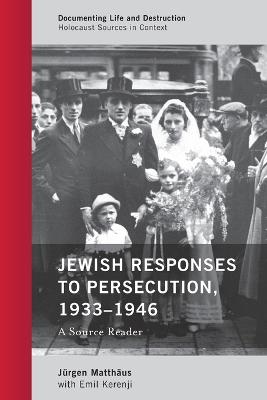Documenting Life and Destruction: Holocaust Sources in Conte
1 primary work • 5 total works
VOLUME 1
Jewish Responses to Persecution
by Director Applied Research Jurgen Matthaus, Jurgen Matthaus, and Mark Roseman
Published 1 January 2009
Jewish Responses to Persecution, 1933-1946 offers a new perspective on Holocaust history by presenting documentation that describes the manifestations and meanings of Nazi Germany's "Final Solution" from the Jewish perspective. This first volume, taking us from Hitler's rise to power through the aftermath of Kristallnacht, vividly reveals the increasing devastation and confusion wrought in Jewish communities in and beyond Germany at the time. Numerous period photos, documents, and annotations make this unique series an invaluable research and teaching tool.
Historians long have analyzed the emergence of the "final solution of the Jewish question" primarily on the basis of German documentation, devoting much less attention to wartime Jewish perceptions of the growing threat. Jurgen Matthaus fills this critical gap by showcasing the highly insightful reports compiled during the first half of World War II by two Geneva-based offices: those of Richard Lichtheim representing the Jewish Agency for Palestine and of Gerhart Riegner's World Jewish Congress office. Since the first days of war, Lichtheim's predictions of Jewish dead ran in the millions and increased progressively with the rising tide of Nazi rule over Europe. His and Riegner's perceptions of German anti-Jewish policy resulted from shared goals and personal experiences as well as from their bureaus' range of functions and the massive problems that impacted the gathering and communicating of information on the unfolding Holocaust in German-controlled Europe. Beyond the specifics of the wartime Geneva setting, these sources show how human cognition works in times of extreme crisis and contribute to a better understanding of the potential inherent in Jewish sources for gauging perpetrator actions. The reports and contextual information featured here reflect the first narratives on the Holocaust, their emergence, evolution, and importance for post-war historiography.
War, Pacification, and Mass Murder, 1939
by Jurgen Matthaus, Jochen Boehler, and Klaus-Michael Mallmann
Published 18 April 2014
This invaluable work traces the role of the Einsatzgruppen of the Security Police and SD, the core group of Himmler's murder units involved in the "Final Solution of the Jewish Question," during and immediately after the German campaign in Poland in 1939. In addition to relevant Einsatzgruppen reports, the book includes key documents from other sources, especially eyewitness accounts from victims or onlookers. Such accounts provide an alternative, often much more realistic, perspective on the nature and consequences of the actions previously known only through documentation generated by the perpetrators. With carefully selected primary sources contextualized by the authors' clear narrative, this work fills an important gap in our understanding of a crucial period in the evolution of policies directed against Jews, Poles, and others deemed dangerous or inferior by the Third Reich. Supplemented by maps and photographs, this book will be an essential reference and research tool.
Combining rich documentation selected from the five-volume series on Jewish Responses to Persecution, this text combines a carefully curated selection of primary sources together with basic background information to illuminate key aspects of Jewish life during the Holocaust. Many available for the first time in English translation, these letters, reports, and testimonies, as well as photographs and other visual documents, provide an array of first-hand contemporaneous accounts by victims. With its focus on highlighting the diversity of Jewish experiences, perceptions and actions, the book calls into question prevailing perceptions of Jews as a homogenous, faceless, or passive group and helps complicate students' understanding of the Holocaust. While no source reader can comprehensively cover this vast subject, this volume addresses key aspects of victim experiences in terms of gender, age, location, chronology, and social and political background. Selected from vast archival collections by a team of expert scholars, this book provides a wealth of material for discussion, reflection, and further study on issues of mass atrocities in their historical and current manifestations.
The book's cover photograph depicts the 1942 wedding of Salomon Schrijver and Flora Mendels in the Jewish quarter of Amsterdam. Salomon and Flora Schrijver were deported via Westerbork to Sobibor where they were murdered on July 9, 1943. USHMMPA (courtesy of Samuel Schryver).
The book's cover photograph depicts the 1942 wedding of Salomon Schrijver and Flora Mendels in the Jewish quarter of Amsterdam. Salomon and Flora Schrijver were deported via Westerbork to Sobibor where they were murdered on July 9, 1943. USHMMPA (courtesy of Samuel Schryver).
The Political Diary of Alfred Rosenberg and the Onset of the Holocaust
by Jurgen Matthaus and Frank Bajohr
Published 28 September 2015
In December 2013, after years of exhaustive search, the U.S. Holocaust Memorial Museum received more than four hundred pages of diary notes written by one of the most prominent Nazis, the Party's chief ideologue and Reich minister for the occupied Soviet territories Alfred Rosenberg. By combining Rosenberg's diary notes with additional key documents and in-depth analysis, this book shows Rosenberg's crucial role in the Nazi regime's anti-Jewish policy. In the second half of 1941 the territory administered by Rosenberg became the region where the mass murder of Jewish men, women, and children first became a systematic pattern. Indeed, months before the emergence of German death camps in Poland, Nazi leaders perceived the occupied Soviet Union as the area where the "final solution of the Jewish question" could be executed on a European scale. Covering almost the entire duration of the Third Reich, these previously inaccessible sources throw new light on the thoughts and actions of the leading men around Hitler during critical junctures that led to war, genocide, and Nazi Germany's final defeat.




